(Multi-page ad section from Audio magazine, Sept. 1985)
Why all previous compact disc players seem merely ordinary...
The Extraordinary ES Series CD Players... from Sony
Digital Audio--In the Beginning
In the past few years, a revolution in sound reproduction has taken place. A revolution that began in the early 1970's when Sony developed a PCM digital recorder for professional use. And in the decade that followed, Sony led the industry in introducing a complete series of professional and consumer digital products that the music world has applauded for their transparent clarity and staggering accuracy.
Then, in 1982, Sony stunned the high fidelity industry by creating the world's first digital audio Compact Disc player. And as co-developer of the CD format, Sony can truthfully claim more extensive experience in the design and construction of Compact Disc players than any other manufacturer.
From the development of the 16-bit linear quantization system to the format's CIRC error correction method; from software production to the first portable and car CD players; after years of research Sony has made Compact Disc a marketing reality! But this is only the beginning.
Sony's ES Series ... The Next Step
Now in one bold stroke, Sony introduces the new ES Compact Disc series.
These limited-production players are the finest ever built by Sony. A line of players so advanced, they take the Compact Disc format to the cutting edge of the future. With sound and performance so spectacular, they are destined to become benchmarks for the industry.
Impressive? Yes! But not unexpected.
Not when you consider the company that started the digital revolution...
Sony's Third-Generation Technology
The foundation on which Sony created the new CDP520 ES, CDP-620 ES, and CDP-650 ESD series of players is our unparalleled third generation engineering. It is the result of extensive research into the traditional problems that are inherent to the digital conversion process.
The Classic Digital Conversion Problem
Perhaps digital's most controversial issue is how to deal with undesirable aliasing noise. Aliasing noise is a by-product of the digital process. Uncontrolled, you would hear it as annoying high frequency distortion.
Some CD players use steep slope-rate analog filters to neutralize this noise. While they are generally effective, the analog filter's "brick wall" effect means that anything above its frequency of operation is completely "chopped" off. Consequently, phase linearity suffers, and uniformity at the highest audio frequencies is only marginal.
Other CD players use a method called "over-sampling" to raise the digital conversion frequency to a point well beyond the audible range. While providing no additional music information, this system has the advantage of providing better high frequency response and minimal phase shift. However, even with both a digital and a final stage analog filter, most oversampling system's more complex circuitry creates additional problems with high frequency spurious noise.
Sony's unique Unilinear Converter and digital filtering system provides the benefits of both previous designs.
Unlike other methods, our high-speed D/A converter utilizes single, "master clock" architecture to synchronize all digital decoding functions. This eliminates the "beat frequencies" caused by the interaction on various clack rates found in typical oversampling designs-along with their dependent frequency irregularities. Data synchronization is theoretically perfect. And frequency response is absolutely unprecedented± 0.1 dB deviation in typical measurements!
And with its integrated system of 88.2 kHz over sampling and high resolution 96th order digital filter, the Unilinear Converter attenuates spurious noise by a remarkable 80 dB! That's almost twice as effective as most conventional oversampling/digital systems. Plus, Sony's digital filter combined with a gentle slope rate final stage analog filter, limits 'ripple' factor to a mere 0.01 db ... as well as contributing to one of the best phase response characteristics in the industry!
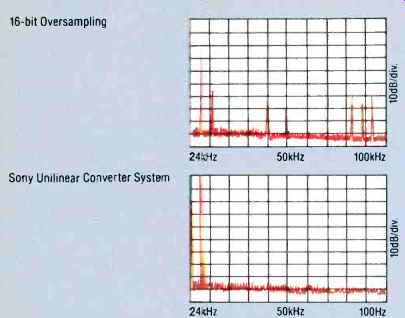
---- Noise Spectrum Comparison 16-bit Oversampling Sony Unilinear Converter
System
No spurious noise. Spectacular frequency response.
Superb phase linearity. Only Sony offers a total solution to the problems created by the digital conversion process.
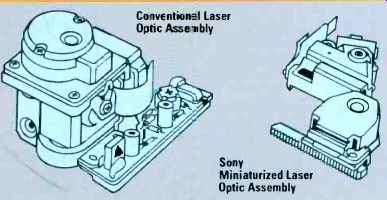
---Conventional Laser Optic Assembly; Sony Miniaturized Laser Optic Assembly
High Density Digital Integration
Another major innovation in Sony's third-generation CD players is our new Very Large Scale Integration (VLSI) circuitry chip. It handles all 9 digital functions (error correction, synch detection, etc.) as a single circuit, thus simplifying the signal path. And Sony's VLSI is also smaller, more efficient, consumes less power and generates less heat. All of which makes it more reliable. (It also makes possible our remarkable car stereo and portable CD players.)
A Laser Fast As The Speed Of Light
A laser pick-up in a CD player requires four main attributes: Blinding speed for fast track access. Excellent stability and reliability. Superior tracking. And a margin for error of less than two microns (a micron is a billionth of an inch). First and second-generation CD players transfer torque from the motor to the pick-up using a complex worm gear and reduction gear: mechanism. Unfortunately, this does not always provide smooth, accurate tracking.
Nor does it balance the contradictory requirements of high access speed and pinpoint cueing.
The result is occasional mis-tracking. And that causes less than ideal performance.
Which is why Sony developed the new third-generation Linear Motor Tracking system. The motor's torque is transferred directly to the pickup. So the worm gear and reduction gears-along with their adverse mechanical effects, like "play" backlash, and friction-are eliminated.
And since it has fewer moving parts, the linear non-cogging motor system is also more reliable.
The Linear Motor Tracking system would not have been practical (or even possible) with the relatively large, heavy laser used in first- and second-generation players.
So we created a new miniature (laser pickup, that's one third smaller and lighter than previous models. Combined with our "3 spot" laser servo, the Linear Motor Tracking system is smaller, more precise, as well as more uniform in operation.

---Sony Linear Motor Tracking System
Best of all, Sony's third generation laser assembly and Linear Motor Tracking system is fast-the fastest in the industry. It can access any location on the disc in less than one second! Try locating a selection with any other CD player. Some take as much as 15 times longer to find a given track.
The True Significance of the "Least Significant Bit"
In the high-performance world of digital audio, small imperfections are much more noticeable. Any weak link in the system reduces the accuracy and quality of the overall sound. So for our ES Series CD players, Sony incorporated our very finest analog parts and components.
A new audio operation amp, for example, has been designed with separate signal paths for the left and right channels. This results in better heat dissipation and lower crosstalk.
Special ceramic-powder electrolytic capacitors transmit their charge more effectively than typical capacitors.
So rise-time and pulse response characteristics are outstanding.
In addition the CDP-650 ESD has dual monaural circuitry mounted on a low resonance copper chassis.
Specially designed insulator "feet" are also included to improve isolation From mechanical vibration.
This attention to detail may seem a bit obsessive to those interested only in specifications. But digital technology demands great imagination and dedication. That's why, for the 650 ESC, 620 ES and 520 ES, every key circuit has been redesigned. Every mechanism rethought. Every feature re-examined.
The result is the finest, most refined, best sounding CD players you can buy. Each backed by an unprecedented three year limited parts and labor warranty.
CDP-520ES--The Most Affordable ES Series Compact Disc Player
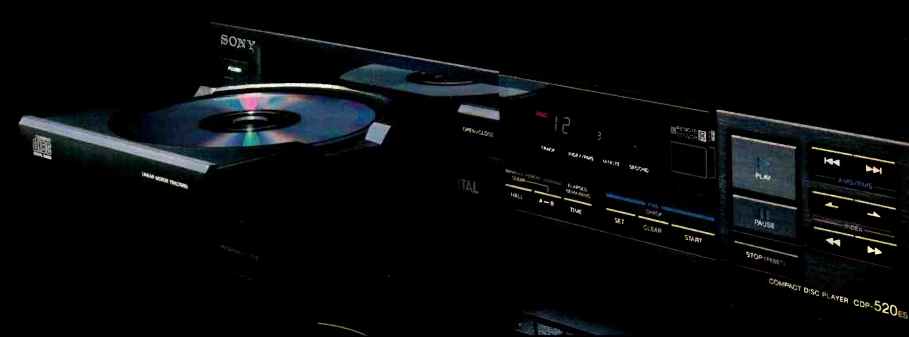
The CDP-520ES offers impressive technology and sophisticated construction
... plus, a wide range of playback options such as 16-selection programmability
and a full-featured infrared Remote Control Commander Tm Unit. Yet, the 520ES
is as easy to use for the novice as it is for the experienced high fidelity
enthusiast. The CDP-520ES ... the player of choice for the serious music listener
looking for value at an affordable price.
"The new Sony CDP-520ES is an excellent example of the state of the art in CD players... unquestionably a top contender in a crowded field, besides being a very good value for the money."
-Julian Hirsch, Stereo Review, July, 1985 ( U.S.A.) "A technical and sonic achievement."
-High Performance Review, Volume 3 Issue 3 ( USA)
"This is in my opinion quite simply the best-sounding CD player I know of."
-J. Gordon Holt, Stereophile, May 1985 ( USA)
A supplied Remote Control Commander allows for convenient usage of the 11 primary operation modes found on the CDP-520ES. The commander also allows you to directly access any selection in less than one second!
Logically positioned in a size/ priority configuration, the CDP-520ES offers a host of playback features from a minimum of controls. Such features as 99 track Automatic Music Sensing (AMS); 16 selection programmability (RMS); 99 subcode indexing; 2 speed music search; as well as play, pause and reset options are included. The 520ES can also be set to repeat a single track, the complete disc, or any portion of music between two (user-selectable) points.
CDP-620ESA---Unique Blend of Performance and Player Design

The CDP-620ES points to a new direction in Compact Disc Player design. A special
Music Calendar/concentrated display is provided to enhance the 20-key one-touch
Direct Music Select front panel controls. Add to this features like Remote
Control Commander"' unit programming and line-out/volume control, and
the CDP-620ES sets the precedent for great sound and convenience.
". . The sound quality is remarkably clear ... (reproduces with) extremely wide dynamic range and exceptional high frequency imaging"
-Sound Record Club, January, 1985 ( Japan)
"... the sound seems to be multi-dimensional ... highly transparent with superior imaging ..."
-FM Fan-Issue #939 ( Japan)
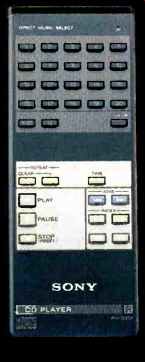
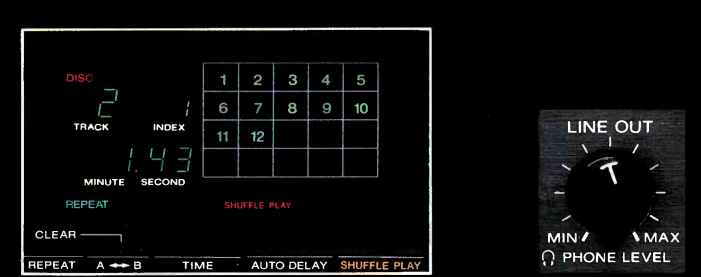
The 20-selection Music Calendar display provides all relevant music information
at a glance ... the number of tracks on the disc ... the player's programmed
selections ... or any single selection being played. These operations can be
combined with Auto Delay, Shuffle Play, or Repeat modes for the utmost in playback
flexibility. An original Sony feature, the variable volume/line-out control
allows you to independently adjust volume level from either the player or from
the supplied Remote Control Commander.'"
CDP-650ESD---The Compact Disc Player of the Future
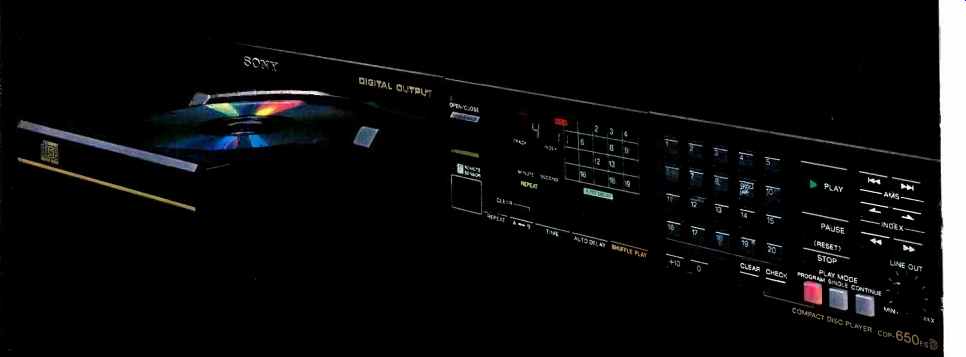
In addition to its remarkable construction and unprecedented capabilities,
Sony's CDP650ESD is the world's first player to offer a digital data output
port. With it, direct interface can be made of music ‘data' into an outboard
digital convertor or digital amplifier for superior sound reproduction. Or
you can listen to the CDP-650ESD by itself via its built-in D/A LSI circuit.
Either way, you'll experience the ultimate performance possible from the CD
format!
"Sound quality of the CDP-650ESD is absolutely magnificent.... Until I can be shown that a better sounding CD player exists, I'm going to consider this model my new standard of reference."
-Leonard Feldman, Audio, July, 1985 (U.S.A.)

The CDP-650ESD employs an anodized copper chassis that holds magnetic radiation
distortion to a minimum. In addition, low impedance, solid copper busbars are
used to offset electrical noise. Unlike conventional designs, the 650's entire
analog and digital circuitry are internally isolated into separate shielded
compartments to keep mutual interference to a minimum.
To reduce dynamic intermodulation distortion, a number of steps have been taken. The CDP-650ESD comes complete with special insulators that help isolate the player's transport from vibration. Furthermore, the player's internal transport is insulated by compliant rubber bushings that help reduce shock transmitted from the chassis. As a final step, resonance-absorbing material is applied to both the complete casing and chassis of the player.
DAS-702ES---The World's First Outboard D/A Convertor

The DAS-702ES has dual monaural, discrete component circuitry that provides
sonic performance second to none. Because all digital products operate at different
sampling rates, you can use the 702ES to decode a diversity of components like
the CDP-650ESD and the PCM-3324 Multi Track Recorder. Plus with the coming
of Direct Broadcast Satellite (DBS) transmissions and Digital Audio Tape (DAT)
recorders, the future for this outboard decoding converter is unlimited. And
unlike built-in LSI converters, the DAS-702ES performs its task without the
usual restrictions imposed by chassis size, single path integration and heat
generation.
"The CDP-650ESD/DAS 702ES combination represents the state-of-the-art so far as CD replay technology and digital decoding are concerned, the technical story being as fascinating as the lab results are interesting ... So far as many important subjective characteristics are concerned, the '702 used to decode the ('650) digital output sounded better than any other commercial player I have auditioned."
-Martin C.. Hi-Fi New & Record Review, June, 1985 ( U.K.)
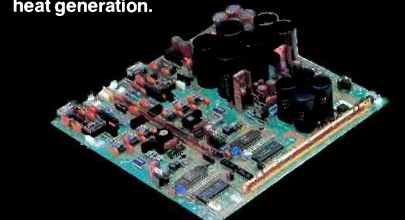
The unique DAS-702ES convertor circuitry employs three different sampling
clock-rates for a multiplicity of applications. Sound quality is enhanced by
the employment of dual-monaural construction throughout: separate high-speed
ladder-type D converters, integrators, line and buffer amplifiers and low-pass
filters. Electrical interference is reduced with multiple power supplies that
incorporate large capacity ceramic-based electrolytic capacitors. Linear crystal,
oxygen-free copper wire (LC-OFC) is used for all analog signal paths: while
all passive components are selected on a sonic basis. As a final step, all
digital stages are fully isolated and mounted on thick, non-resonating alloy
material and reinforced throughout.
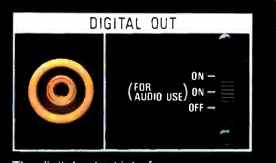
The digital output interface transmits both the L and R channel data using
a single digital cable. When in use, both audio and graphic data can be processed
simultaneously, or the audio data can be processed only. In the off position.
the CDP-650ESD's built-in D/A converter allows you to process the signal conventionally,
through the analog amplifier stage.
(adapted from Audio magazine, Sept. 1985)
Also see: Sony components (April 1975)
= = = =